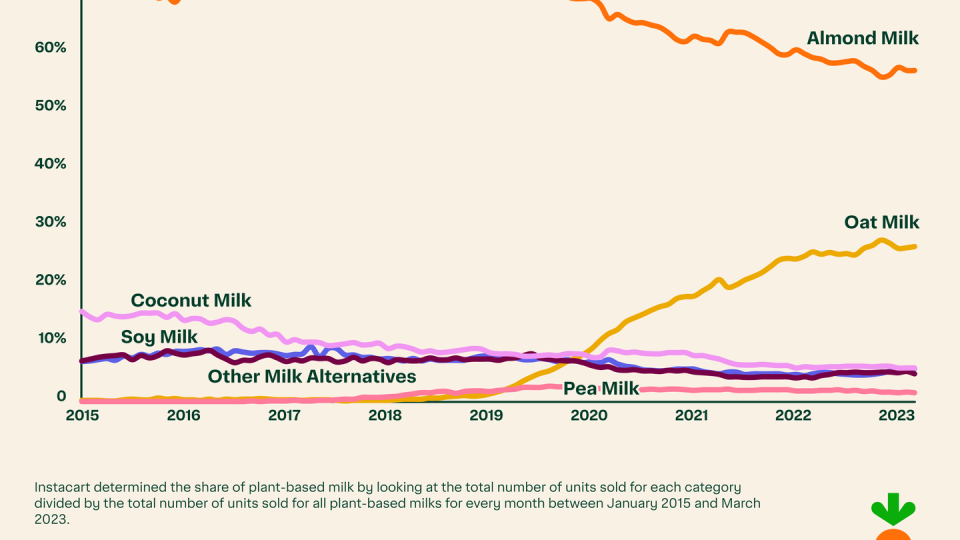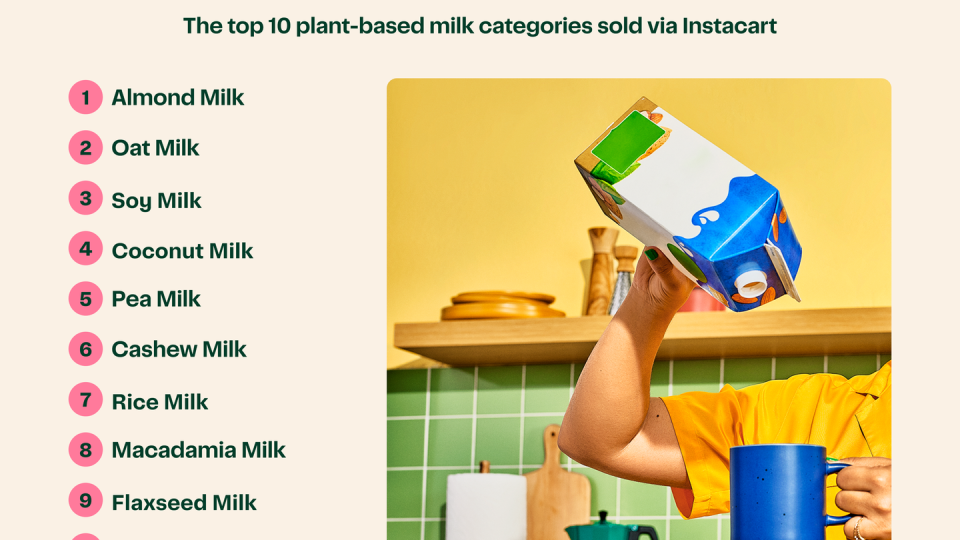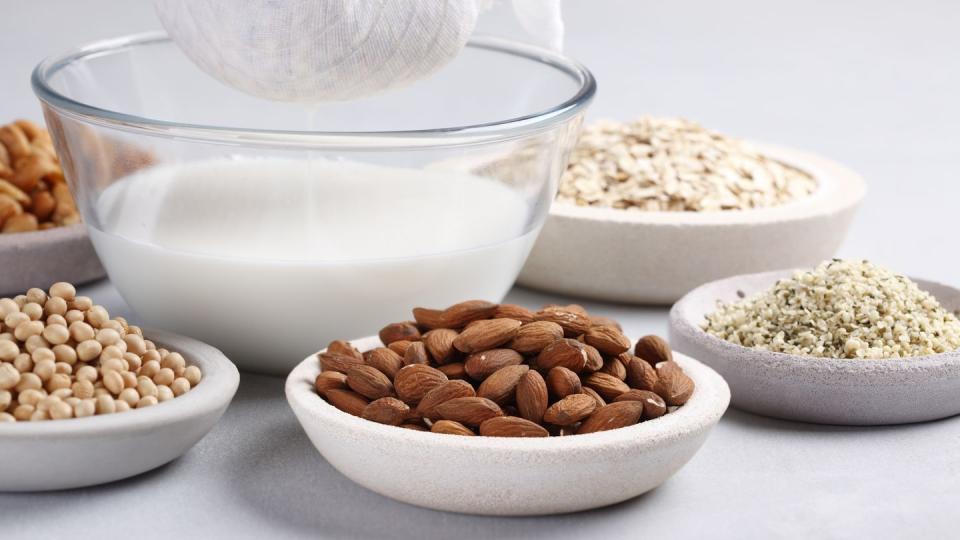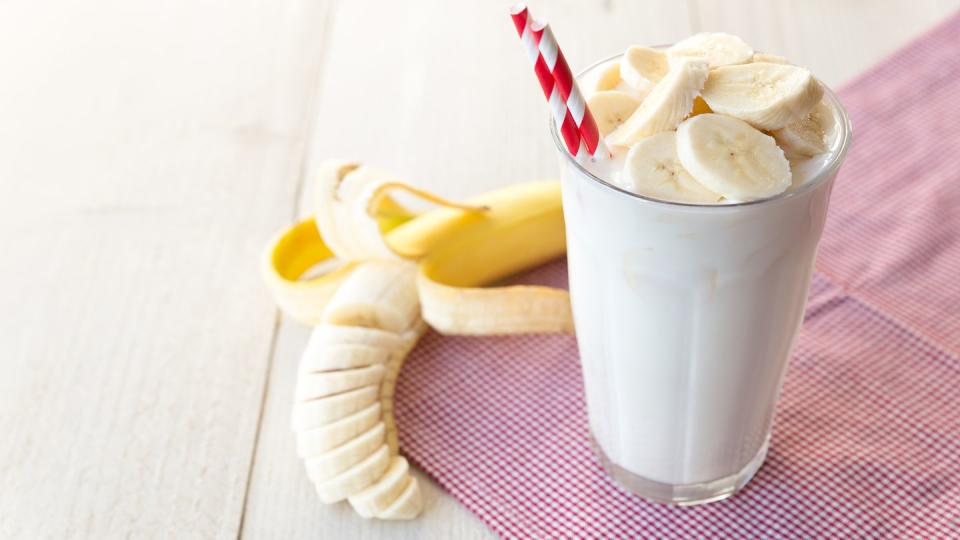These Are the Best Milk Alternatives to Drink Instead of Dairy
"Hearst Magazines and Yahoo may earn commission or revenue on some items through these links."
[table-of-contents] stripped
While good ol’ dairy milk is still the default milk option, plant-based milk alternatives have carved out a niche in the milk market. While some people prefer plant-based milk because they are lactose intolerant or vegan, others may opt for non-dairy milks for ethical or taste reasons. Many people simply prefer the flavor of common milk alternatives such as oat and almond. Plus, with plant-based milk, there is no need to worry about the conditions and quality of life of the animal producing it. With the expert help of Ilana Muhlstein, a nutritionist, dietician, and author of You Can Drop It!, we’ve put together a list of the top milk alternatives, so you can make the perfect cup of joe or baked good without sacrificing your taste or values.
According to Google Trends, the interest in milk alternatives has been on the rise since 2009. While we can’t be certain what caused this peak in interest, we can confidently say the milk alternative market is growing at a rapid pace. What started as a battle between almond and soy milk has grown into a full-fledged drink category, spanning from nut milks to grain milks to legume milks and more. At this point we’re asking ourselves, what can’t be turned into milk? And so far, the jury’s still out.
What is a milk alternative?
As the name implies, milk alternatives are substitutes for dairy milk (i.e. whole milk, 2%, 1%, and skim, as we more commonly refer to them). According to Instacart data collected from 2015 to 2023, the most popular milk alternatives are almond milk, oat milk, and coconut milk, which can be easily found at local grocery stores and coffee shops. These milk alternatives can be used in place of cow’s milk when cooking, drinking, or eating, and often have a longer shelf life than dairy milk.

Why should you choose a milk alternative?
There are many reasons people opt for a milk alternative instead of the typical dairy. They may have an allergy or intolerance to cow’s milk and its ingredients such as lactose. They may adhere to a vegan diet, which does not allow for the consumption of foods derived from animals. They could also prefer the taste of milk alternatives since plant-based milks tend to be quite neutral or nutty in flavor. Other, often underrated, reasons for drinking milk alternatives are their shelf life and carbon footprint. Many plant-based milks have fewer environmental impacts than dairy milk and can be stored in the pantry for months without expiration.
As great as milk alternatives sound, they still have their downsides. As nutritionist and dietician Ilana Muhlstein notes, “The drawbacks are that many milk alternatives are low in protein and contain added sugars, oils, and emulsifiers.” Proteins are what help muscles grow big and strong. And while sugar may better a milk's taste, it can also contribute to weight gain. That’s why you need to know what to look for when shopping.
What to look for when selecting a milk alternative:
✔️ Additives: Watch out for additives, specifically gums, Muhlstein says. "Additives like xanthan gum and guar gum are used to thicken nut milks and may cause GI distress for those with irritable bowel syndrome (IBS)." So take note of the ingredients in the milk alternative you’re selecting.
✔️ Allergens: Check for traces of common allergens. “Often, plant-based milks have blends of other ingredients,” says Muhlstein. “For instance, coconut milk beverages are often made using a mix of almond milk.” While some milks may seem allergen-safe, it’s best to double-check the ingredient list, even for items you may not think are present.
✔️ Fortified Nutrients: Buy a milk alternative with fortified nutrients such as calcium and vitamin D. “If you are switching from [cow’s] milk to a milk alternative, you want to ensure you are getting a fortification of these essential nutrients,” she says. Calcium and other key supplements are vital to your health, promoting bone mass, strength, and development — especially in children.
✔️ Calories: Though milk alternatives may seem healthier than dairy milk, they often boast high calorie counts. “Unsweetened cashew and almond milk typically contain under 45 calories per cup [while] some nut milk varieties have 60-90 calories per cup, due to added sugars,” says Muhlstein. “I recommend asking your coffee shop or restaurant to show you the carton before ordering [a] grande latte [because] you might decide to switch to an americano with just a splash of milk instead.”
What milk alternative is best for you?
Best Milk Alternative for Coffee: Oat Milk
Of all the milk alternatives, oat milk pairs the best with coffee. “Oat milk performs really smooth and creamy in hot coffee, which is why many people have started using it regularly,” says Muhlstein. Other popular milks, such as soy and nut milks, can curdle because of coffee’s high pH. Oat milk is also great in iced coffee. Its smooth, creamy flavor comes through, no matter the temperature.
Best Milk Alternative for Baking: Soy or Unsweetened Almond Milk
“Nutritionally, soy milk is most similar to [cow’s] milk, [so it] performs fairly well in baked recipes, creamy soups, and instant pudding mixes, while maintaining protein content,” Muhlstein says. If you’re not a fan of soy milk’s strong taste, she recommends opting for unsweetened almond milk — that’s what she uses in her pureed soup recipes.
Best Milk Alternative for Cereal: Any Nut Milk, Oat Milk, or Soy Milk
There are many tasty, viable options when consuming a milk alternative with cereal. “Most of the nut milks, oat milks, and soy milks perform well in cold situations like a bowl of cereal or iced coffee,” says Muhlstein. So at that point, it comes down to flavor preference. “Soy milk is a great high protein milk alternative, but has a strong taste that some people find overbearing in coffee and tea. I would only recommend using it to those who enjoy the taste,” she says.
Top 10 milk alternatives

Almond Milk
Almond milk dominates the milk alternative market, as approximately six out of every 10 plant-based milk purchases are almond — though its popularity is waning with the rise of oat milk. Almond milk is produced by soaking almonds in water, grinding the mixture, then filtering. Muhlstein recommends almond milk to many of her clients because it’s “low in calories and fat while also high in vitamin E.” Because of its strong nutty flavor, almond milk works well in baked treats, french toast, and bread pudding.
Flavor: Strong nutty flavor similar to that of amaretto
Pros: Comes in many varieties such as sweetened, unsweetened, and vanilla-flavored, widely available, low in calories
Cons: Requires a lot of water
Oat Milk
Oat milk is the ‘it milk’ of the moment. It’s created by milling oats and water together then straining. It’s an easy introduction to plant-based milks, as it has a similar taste and mouth-feel to dairy milk, with no outstanding or off-putting flavors. Oat milk pairs well with coffee and smoothies because it can be easily frothed for a velvety, creamy texture. However, Muhlstein does not recommend oat milk for people who are trying to lose weight. “[It's] higher in carbohydrates and lower in protein,” she says.
Flavor: Similar to cow’s milk but sweeter. Slight aftertaste of oats.
Pros: Mild taste, rich and creamy texture, widely available
Cons: Contains a high amount of sugar and carbs, low in protein, can be pricey
Soy Milk
As one of the first milk alternatives to hit the mass market, soy milk has developed a strong, devout following. It’s made by soaking soybeans in water for an extended period of time then grinding and filtering. It’s also Muhlstein’s favorite milk alternative. “Unsweetened, organic soy milk is my go-to choice for adding a splash of milk to my coffee,” she says. “I also enjoy the flavor and the added boost of satisfaction.” It’s available in most coffee shops and grocery stores, meaning it’s easy to get your hands on. It’s especially tasty when mixed with oatmeal for a boost of protein in the morning.
Flavor: Strong taste of soybeans and grass
Pros: High in protein, creamy texture, comes in many varieties such as sweetened, unsweetened, and vanilla-flavored, widely available
Cons: Divisive flavor
Coconut Milk
Coconut milk is in fact different from coconut water. Coconut milk is made by grating the white of coconuts, mixing it with hot water, then straining. For those who don’t love the nutty flavor of almond or macadamia nut milk, coconut is a great alternative. It offers a sweet fruitiness that pairs well with creamy soups and curries. But watch out for added sugars that can hike up the calorie count.
Flavor: Strong coconut taste with slight sweetness
Pros: Reduces inflammation, creamy texture, widely available
Cons: Can be pricey, often high in calories
Pea Milk
Don’t worry, pea milk is not a derivative of the green peas you eat at dinner. Pea milk is made from yellow field peas that are finely milled and blended with water. Because of its similarity in taste to cow’s milk, people often enjoy pea milk with cereal or on its own.
Flavor: Similar to cow’s milk but milder
Pros: High in protein, creamy texture, comes in many varieties such as sweetened, unsweetened, and vanilla-flavored
Cons: Some claim it has a chalky, flour-like taste

Cashew Milk
Similar to other milk alternatives, cashew milk is created by immersing cashews in water, draining them, and then blending. Cashew milk is a milder alternative to almond milk, as it has a subtle nutty and creamy flavor without overpowering whatever it’s mixed with. Cashew milk is great in ice cream, soup, and cereal because of its creaminess and subtle flavor.
Flavor: Slightly sweet with minimal nuttiness
Pros: Low in calories, creamy texture, comes in many varieties such as sweetened, unsweetened, and vanilla-flavored
Con: Low in protein
Rice Milk
Though it may have a large environmental impact compared to other milk alternatives, rice milk is great for those with allergies or intolerances, as it's hypoallergenic. You can enjoy it without the adverse effects of dairy, soy, or nuts. Rice milk is made by pressing rice through a grinding mill then straining and blending with water. It’s especially great when mixed with flavors of cinnamon, vanilla, or banana like in a yogurt parfait or hot chocolate.
Flavor: Similar to cow’s milk with a slight rice taste
Pros: Naturally sweet, great source of calcium, hypoallergenic
Cons: Produces the most greenhouse gasses of any plant milk, requires a lot of water, thin consistency
Macadamia Milk
This lesser known nut milk is made by soaking macadamia nuts in water overnight, blending, and straining. Its thick, creamy texture can be easily frothed, making it great for topping. It’s also good with granola or mixed with chocolate for desserts. Many trend reporters claim macadamia milk will be the next “it milk” like oat milk because of its growing popularity.
Flavor: Present nutty flavor with slight sweetness
Pros: Creamy texture, reduces inflammation, includes healthy fats
Con: Low in protein
Flaxseed Milk
Because flaxseed milk is so easy to make, many opt to make it at home. Simply mix flaxseeds and water then blend. Afterward, strain through a fine cloth. Add flax milk to baked goods for an extra boost of fiber or as a replacement for eggs, as it naturally thickens. Because of its high fiber content, it may be best to skip pairing it with coffee.
Flavor: Mild nutty flavor with a hint of bitter earthiness
Pros: High in fiber, thick and creamy texture, includes healthy fats, easy to make at home
Cons: Low in protein
Hemp Milk
Whether to your delight or dismay, hemp milk does not contain THC or CBD — two common extracts found in the marijuana plant. Hemp milk is made using only hemp seeds, which do not carry the same properties as their flower and bud counterparts. The milk is produced by blending hemp seeds and water then straining. It’s particularly good in protein shakes and smoothies because of its nutritional qualities.
Flavor: A mix of nutty and earthy flavors with slight sweetness
Pros: High in protein, includes healthy fats, thick and creamy texture, easy to make at home
Cons: Often high in sugar, can be pricey
Lesser known milk alternatives

While you may be familiar with almond, oat, and soy milk, as well as others on the top 10 list, you may not have heard of these other milk alternatives. Some are quite new, others quite wacky, but it’s up to you to decide if they're delicious.
Lesser known milk alternatives include: Sesame milk, potato milk, barley milk, banana milk, quinoa milk, pistachio milk, hazelnut milk, and chia seed milk. The milk alternative market continues to grow with new brands and inventions. So if you haven’t found one that suits your palate just yet, hold on. There are likely more on the horizon.
You Might Also Like

